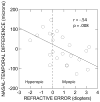Vitreo-retinal traction and anastrozole use
- PMID: 18712596
- PMCID: PMC2728165
- DOI: 10.1007/s10549-008-0156-5
Vitreo-retinal traction and anastrozole use
Abstract
Purpose: This study tested a prediction stemming from the hypothesis that anastrozole users experience heightened vitreo-retinal traction. This hypothesis was based on the knowledge that menopause increases the risk of intraocular tractional events such as posterior vitreous detachments (PVDs).
Methods: Retinal thickness was measured for 3 groups of amenorrheic women: (1) anastrozole users and (2) tamoxifen users undergoing adjuvant therapy for early-stage breast cancer, and (3) control subjects not using hormonal medication. Foveal shape indices were derived for subjects without PVDs.
Results: For anastrozole users, the distance to the temporal side of the fovea became less than the distance to the nasal side at a sufficient height above the foveal base. This effect did not exist for control subjects; the between-group difference was appreciable. Results concerning tamoxifen users were inconclusive.
Conclusions: The foveas of women using anastrozole appear to be subjected to more tractional force than are the foveas of women not using any hormonal medication.
Figures




Similar articles
-
Retinal hemorrhages in anastrozole users.Optom Vis Sci. 2008 May;85(5):301-8. doi: 10.1097/OPX.0b013e31816bea3b. Optom Vis Sci. 2008. PMID: 18451730
-
Comprehensive side-effect profile of anastrozole and tamoxifen as adjuvant treatment for early-stage breast cancer: long-term safety analysis of the ATAC trial.Lancet Oncol. 2006 Aug;7(8):633-43. doi: 10.1016/S1470-2045(06)70767-7. Lancet Oncol. 2006. PMID: 16887480 Clinical Trial.
-
Anastrozole as adjuvant therapy for early-stage breast cancer: implications of the ATAC trial.Clin Breast Cancer. 2003 Apr;4 Suppl 1:S42-8. doi: 10.3816/cbc.2003.s.014. Clin Breast Cancer. 2003. PMID: 12756078 Review.
-
Assessing the risk of bone fracture among postmenopausal women who are receiving adjuvant hormonal therapy for breast cancer.Curr Med Res Opin. 2007 May;23(5):1045-51. doi: 10.1185/030079907x187919. Curr Med Res Opin. 2007. PMID: 17519070
-
Three years' follow-up from the ATAC trial is sufficient to change clinical practice: a debate.Breast Cancer Res Treat. 2003;80 Suppl 1:S3-11; discussion S13-8. doi: 10.1023/a:1025455130476. Breast Cancer Res Treat. 2003. PMID: 14535530 Review.
Cited by
-
A case report of cystoid macular edema, uveitis and vitreomacular traction in a patient taking Anastrozole.Am J Ophthalmol Case Rep. 2022 Jan 22;25:101339. doi: 10.1016/j.ajoc.2022.101339. eCollection 2022 Mar. Am J Ophthalmol Case Rep. 2022. PMID: 35128169 Free PMC article.
-
Ocular Side Effects of Aromatase Inhibitor Endocrine Therapy in Breast Cancer - A Review.In Vivo. 2022 Jan-Feb;36(1):40-48. doi: 10.21873/invivo.12674. In Vivo. 2022. PMID: 34972698 Free PMC article. Review.
-
Ocular side effects of biological agents in oncology: what should the clinician be aware of?Onco Targets Ther. 2013 Dec 24;7:69-77. doi: 10.2147/OTT.S54606. Onco Targets Ther. 2013. PMID: 24391443 Free PMC article. Review.
-
Breast cancer medications and vision: effects of treatments for early-stage disease.Curr Eye Res. 2011 Oct;36(10):867-85. doi: 10.3109/02713683.2011.594202. Epub 2011 Aug 5. Curr Eye Res. 2011. PMID: 21819259 Free PMC article. Review.
-
The effects of systemic aromatase inhibitors on meibomian glands and corneal structure.Eye (Lond). 2022 Jun;36(6):1185-1193. doi: 10.1038/s41433-021-01612-z. Epub 2021 Jun 11. Eye (Lond). 2022. PMID: 34117393 Free PMC article.
References
-
- Conte P, Frassoldati A. Aromatase inhibitors in the adjuvant treatment of postmenopausal women with early breast cancer: Putting safety issues into perspective. Breast J. 2007;13:28–35. - PubMed
-
- Buzdar AU, Coombes RC, Goss PE, et al. Summary of aromatase inhibitor clinical trials in postmenopausal women with early breast cancer. Cancer. 2008;112:700–709. - PubMed
-
- Partridge AH, LaFountain A, Mayer E, et al. Adherence to initial adjuvant anastrozole therapy among women with early-stage breast cancer. J Clin Oncol. 2008;26:556–562. - PubMed
-
- Howell A, Cuzick J, Baum M, et al. Results of the ATAC (Arimidex, Tamoxifen, Alone or in Combination) trial after completion of 5 years’ adjuvant treatment for breast cancer. Lancet. 2005;365:60–62. - PubMed
-
- Garreau JR, Delamelena T, Walts D, et al. Side effects of aromatase inhibitors versus tamoxifen: the patients’ perspective. Am J Surg. 2006;192:496–498. - PubMed
Publication types
MeSH terms
Substances
Grants and funding
LinkOut - more resources
Full Text Sources
Medical

